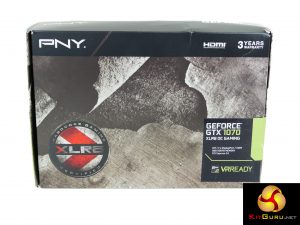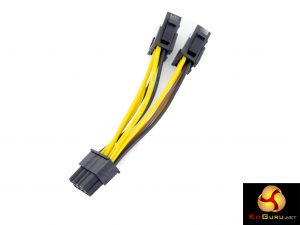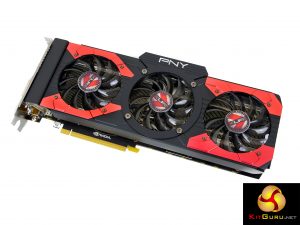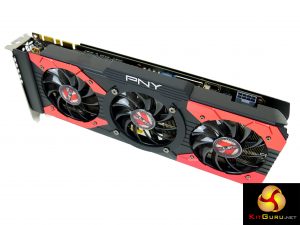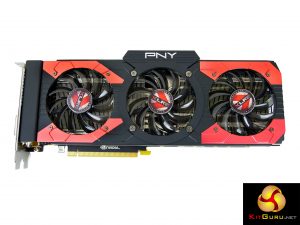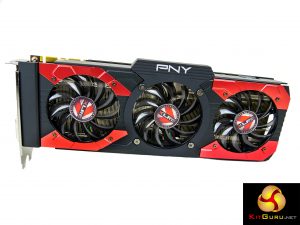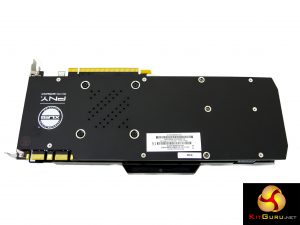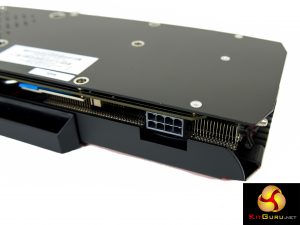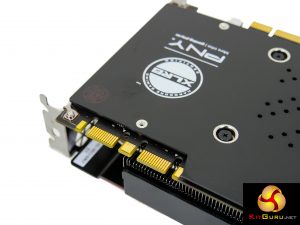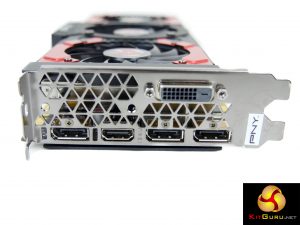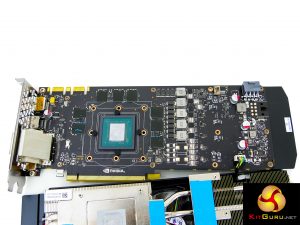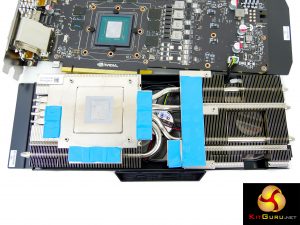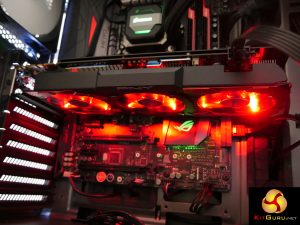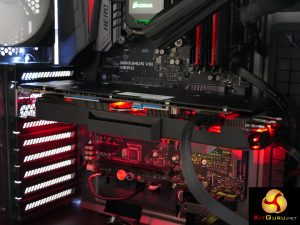PNY sends the GTX 1070 XLR8 OC graphics card in basic packaging with a bundle that includes documentation, the drivers CD, and a very ugly dual-6-pin to 8-pin PCIe power connector.
Bin the CD and download the latest drivers from Nvidia and kiss goodbye to your good-looking build if you are forced to use the yellow-and-black PCIe power adapter.
A quite light red and a dark brown are the two tones used for PNY’s styling on the GTX 1070 XLR8 OC. The red accents have a slightly metallic finish to them which helps to bounce small pockets of light. A dark, translucent plastic is also used for the 80mm fans’ blades and this helps the bright red LEDs to shine through.
By virtue of its XLR8 cooler with triple 80mm fans, the card itself measures in at just under 30cm in length. Width is extended by around 1cm to provide the mounting location for the PNY logo. This seems a little pointless as there could be scenarios where any extra card width can cause interference issues (small SFF cases, for example).
PNY’s XLR8 did not operate with a 0dB fan mode in our testing, which is disappointing. Aside from completely eliminating noise output from the card’s cooler, stationary fans help to enhance their usable lifespan by minimising wear and tear and also reduce the amount of dust blown into the aluminium fin array.
A full-cover black backplate is fitted on the card to improve heat dispersion on the rear of the PCB and to also aid its aesthetics. The styling of the backplate is simple and effective – there are not explicit cut-outs for logos or graphics and a complete lack of LEDs may appeal to some people.
However, PNY prints its logo and text facing the opposite direction of a typical installation inside one’s chassis. With the graphics card installed, the logo and text will appear 180° in the wrong orientation compared to where a user sits and looks through their chassis side panel. This is a minor point but it is also a clear oversight on PNY’s behalf.
Positioning of the ugly barcode sticker is also questionable. This will be mounted front-and-centre when the card is installed in one’s system. Hiding it away in one of the corner of the backplate would have been a smarter design decision.
The 150W TDP GP104 GPU sips power from a single 8-pin PCIe connector mounted on the side of the card. Given the standard-width PCB, there should be no interference problems pressing down the clips on a PCIe power connector when attaching or removing it.
Two SLI fingers are found in their usual location. Given PNY’s use of a reference PCB, this XLR8 OC model can be used in SLI with another reference-style GTX 1070 (such as the FE) as the rigid HB SLI bridge will be positioned correctly. A wider-than-standard card would not allow for SLI between itself and a reference PCB alternative.
PNY sticks to the GTX 1070’s default configuration when it comes to display outputs. Three DisplayPort 1.4 connectors, an HDMI 2.0b, and Dual-link DVI-D (no analogue pins) form the display output options. 4K60 connections can be made using the DP 1.4 and HDMI 2.0b ports. 8K60 or 4K120 can also be output using the DisplayPort connections. Dual-link DVI-D is fine for resolutions such as 1920×1080 or 2560×1440 at 60Hz.
A significant amount of venting is used on the rear slot in an attempt to lessen the resistance for air trying to exit the graphics card and chassis.
Removal of the triple-fan XLR8 cooler reveals the reference-design GTX 1070 PCB used by PNY. There are slight tweaks to the chosen power delivery electronics but the adjustments are minor and should not impact aftermarket cooler compatibility.
Four heatpipes (presumably manufactured from nickel-plated copper) are given flattened sections that make contact with a large baseplate which acts as the first point of contact to the GPU die. The section above the heatsink baseplate will receive a significant amount of thermal energy from the GPU, while the four heatpipes transfer additional heat to outer edges of the aluminium fin arrays for it to be dissipated.
I like this design. It avoids the issues of poor contact by certain heatpipes in an alternative Heatpipe Direct Touch (HDT) solution. And a total of four heatpipes looks to be adequate given PNY’s smart routing of them with respect to the primary contact plate location and the size of each fin array. One slight issue, however, is that the centre 80mm fan is not pushing most of its air onto a section of the fin arrays. This may work well for reducing PCB and inductor temperatures but it does little to aid the overall GPU and memory/MOSFET cooling solution.
Eight memory chips form the 8GB GDDR5 buffer used by the GTX 1070. PNY uses thermals pad to enable cooling of the memory chips which is good to see and may aid component longevity. The hot-running MOSFETs are also cooled by means of a thermal pad linking them to an actively cooled section of the aluminium heatsink.
Dark red LEDs shine brightly through the fan blades of the XLR8 cooler. If you like red, this card is likely to have you very pleased as the colour is bright and the tone of red is bold. Plenty of light spills beneath the card and illuminates hardware beneath it very well. It would have been nice for more of the light to spill out of the sides and become visible when installed inside one’s system.
It is, however, disappointing to see that only red colouring is available in today’s world of RGB-everything. Equally disappointing to some users will be the inability to deactivate the LED lighting.
Be sure to check out our sponsors store EKWB here
 KitGuru KitGuru.net – Tech News | Hardware News | Hardware Reviews | IOS | Mobile | Gaming | Graphics Cards
KitGuru KitGuru.net – Tech News | Hardware News | Hardware Reviews | IOS | Mobile | Gaming | Graphics Cards


